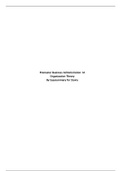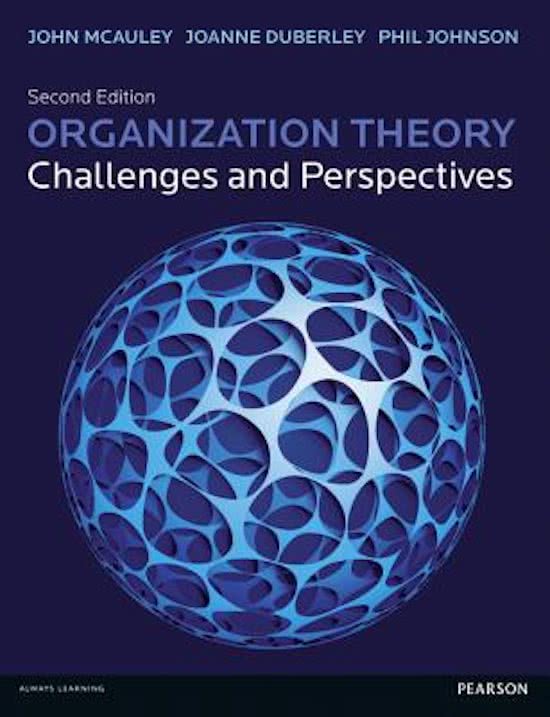Premaster Business Administration 1A
Organization Theory
By Easysummary for Stuvia
,Table of content
McAuley chapter 5 ........................................................................................................ 3
McAuley chapter 6 ........................................................................................................ 6
McAuley chapter 7 ........................................................................................................ 9
McAuley chapter 9 ...................................................................................................... 15
McAuley chapter 10 .................................................................................................... 20
Easysummary 2
,McAuley chapter 5
Neo-modernist organization theory: surfing the new wave?
New-wave theory (1980’s): the emergence and the development of culture as a key control strategy have
been characterized as ‘new-wave management’. It draws on the human relations movement and ideas of
culture and commitment, and is therefor neo-modernist.
Lean manufacturing: flexible manufacturing with highly trained and paid employees and participation.
Key elements in any formal system of control
• Objectives means, disciplinary apparatus and rewarding/punishment
Surveillance might be
• Vertical: managers observe behaviour and collect and store information about the subordinates’
task performance
• Horizontal: involves peer review with team members formally monitoring aspects of each others
task performance
One of the key issues in modernist and neo-modernist organization and management theory is control.
• Informal control: the practices, values, norms, beliefs, unofficial rules, as well as the complete
network of social relations, membership patterns and centres of influence and communication.
• Formal control: refers to everyday processes and practices whereby attempts are made to ensure
that members’ potential labour power is realized in relation to their organization tasks.
o Bureaucratic control (modernist): identification of, and control through, rules that pre-
specify appropriate task behaviours. Task discontinuity: when tasks are complex,
unpredictable and unanalyzable this knowledge may not exist and therefore tasks cannot
be subjected to bureaucratic hierarchical ordering. Therefor it becomes necessary to
develop alternative forms of control. The role of bureaucratic control in new-wave theory:
▪ Increased complexity of the organizational environment requires an escape from
the narrow bureaucratic confines of modernism, but a degree of bureaucratic
structure is needed in order to maintain boundaries and roles within the
organization.
▪ Bureaucratic structures could be abandoned so that there is no longer a
distinction between thinking and doing.
o Output control (modernist): identification of, and control through, the output achieved by
the operative by completing a task, rather than how they should do the task. People are
rewarded for apparent success and punished for apparent failure by the output-based
system. Output control in new-wave theory:
▪ total quality management means continuing improvement with a focus on that the
outputs are both economical and meet customer requirements. Crucial for the
success of TQM is an appropriate organizational culture with strong leadership
and organizational management.
o Cultural/normative/clan control (new-wave management): an attempt to influence what
employees subjectively bring with them to their work (their values and beliefs) so that all
are committed to the goals prescribed by the management to create a culture of
excellence. The danger is that people are manipulated and they are not aware of it, in
contrast to bureaucratic control where they are aware of what is going on
Easysummary 3
, What seems to be the focus of this new-wave stance is corporate culture/visionary company rather than
organizational culture. Corporate culture refers to the values and meanings espoused by senior
management, the latter refers to the probably diverse cultural patterns that exist in an organization – the
informal organization.
Culture change management is a technical process that involves the application of management recipes
derived from new-wave theory, which is done to less knowledgeable others whose existing values and
belies are thought to be somehow problematic, and therefore in need of remedial treatment. Successful
cultural control:
• Internalization of the prescribed cognitive and affective system must have occurred
• Compliance: conforming behaviour of a person who is motivate by a desire to gain a reward and/or
avoid punishment and lasts only as long as the promise or threat of sanction exists.
• Identification: a desire to be like the people who are exerting the influence upon the individual
Radical change: since 1980, organizations confront a time of discontinuous and accelerating social,
economic and technological change along with heightened levels of competition on a global scale. Drivers
stirring change faster: changes in technology, the changing role of government in business, globalization
and collapse of the mass production system.
1: both output controls (selecting measureable outputs) and bureaucratic controls (detailed knowledge of
employees tasks) are viable
2: because tasks are not pre-programmable, output controls are viable, but bureaucratic controls are not
3: bureaucratic controls are viable but output controls are not
4: both output controls and bureaucratic controls are not viable, for it is impossible to measure output and
tasks are exceptional, and therefore cultural controls may be the only viable source of control because
control is based on shared values and goals and the development of strong feelings of solidarity
Easysummary 4






